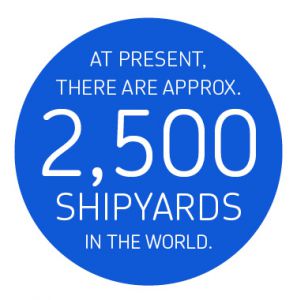Shipbuilding is considered to be one of the oldest industries in world. For thousands of years, ships have constantly evolved to become bigger, safer, and faster—from the small wooden rafts and canoes of ancient times to the gigantic container ships and cruise liners of today. But even in recent history, the industry has weathered many rough patches and crises. Time and time again, technology and innovation have thrown the sector a lifeline during these difficult periods.
A fiercely contested market
Since it typically takes at least two years to complete the construction of a ship, shipbuilding is an extremely strategic and competitive market, with vast sums of money involved. There have been many changes in which country has led the industry. The lower-cost, higher-volume shipbuilders in Asia have dominated the market since the 1960s, taking market share from European shipyards. In the first half of 2017, China, Japan, and South Korea had 77% of the shipbuilding market share in terms of compensated gross tonnage: which is seven times the share of all 28 EU countries and Norway put together.

This dominance is generally attributed to cheaper wages combined with strong government backing and large subsidies. However, even in Asia, shipbuilding is still a volatile market. A prime example is the 2017 bankruptcy of South Korean giant Hanjin Shipping, which was once one of the world’s largest shipping companies. And this isn’t an isolated incident. Economic instability, such as the global financial crisis of 2008, leads to a drop in demand. To tackle the resulting overcapacity, the shipbuilding industry then has to consolidate. Shipyards are often forced to either merge, change hands, or shut down.
The latter option is something that governments want to avoid, as a single shipyard employs thousands of workers. This is the reason that the South Korean and Chinese governments have injected significant sums of money into shipbuilding to keep the industry afloat. On the other hand, government assistance can actually have an adverse effect by causing overcapacity. It is crucial that governments find the right balance as not to warp the market too much.
Technology to the rescue
A number of innovative technologies could help shipyards themselves become more efficient and competitive. Modular construction, for example, could help save significant time in the shipbuilding process, leading to a faster return on investment. Automated shipyards also promise to boost productivity and help solve the problem of an aging workforce. In addition, 3D printing has already been used to manufacture components such as propellers, and could cut the costs of producing prototypes. One of the newest technological developments is the concept of digital twins. These are exact digital replicas of real ships, including all onboard systems. Shipyards could leverage this technology to simulate new and existing vessels, enabling safer, more cost-effective construction.
The industry needs to use all available technology to a much greater extent, and increase technological innovation to reduce CO2 emissions to the ambitious degree required by the international community.
Source: World Maritime News
Innovative shipyards set for growth
New ship technologies present numerous opportunities for shipyards. Adapting designs and equipment to meet environmental targets is a necessity, and the sooner shipyards can implement these upgrades, the more success they will achieve. Furthermore, by embracing trends like AI and digitization, shipbuilding companies can contribute to improving the industry by creating more efficient and less harmful systems. And by building better ships, shipyards could help accelerate the recovery of the maritime industry as a whole.
